AMD is cranking our affordable Triple and Quad core CPU’s like never before. Today we look at the Uber affordable Athlon 2 X3 435 which is expected to debut at $87, Athlon anyone?
INTRODUCTION
AMD is cranking out processors in every price range and market segment faster than most of us can keep track of. They’ve released everything from dual core Athlon 2 X2 to Quad core Phenom 2 X4 and done so in an almost impossibly fast schedule. The new Athlon 2 line is more for budget minded end users and we’ve seen quad core Athlon 2 X4’s as low as $99 which is unheard of for any quad core CPU until now.
With AMD covering every market segment and price range they new lineup of CPU’s is very attractive from a price performance standpoint. Your not going to get Intel i7 975 performance from the new CPU’s but your also not going to pay in $1000 for a CPU. With the ability to run on AM2 or AM3 motherboards and use DDR2 or DDR3 AMD has the most affordable upgrade path and if need be you can incrementally upgrade. Start with a AM2 board with DDR2 sitting on it and plug in an AM3 (any model) CPU and upgrade the board and ram later if you want.
We’re going to take a look at the new AMD Athlon 2 X3 435 triple core CPU and see if we can’t unlock it’s potential, then we’re going to try and unlock that disabled core. You should know that unlocking that disabled core is a crap shoot and not every Triple core CPU can handle it. We’d venture a guess that as many as 50% of the triple cores are capable of unlocking and functioning. That usually comes at a cost, most often you lose a little OCing capability. Typically an unlocked core CPU that overclocks to 3.GHz will OC as high as 3.5GHz so you lose 300 – 400 GHz OCing capability but gain a core. Other triple core CPU’s won’t stabilize with the core unlocked. If you have a little luck and a board capable of the trick you might extend the already great value of affordable AMD CPU’s. Even if it doesn’t unlock the Athlon 2 X3 435 running a mere $87 dollars at launch is still an exceptional value for budget minded enthusiasts.

Lets jump right into the specifications of the Athlon 2 X3 435 and see how far we can drive it.
| CPU Name | Cores | Clock | L2/L3 Cache | HT Bus | Socket | TDP | Price |
| AMD Phenom II X4 965 BE | 4 | 3.4GHz | 2+6MB | 4000MHz | AM3 | 140W | $179 |
| AMD Phenom II X4 955 BE | 4 | 3.2GHz | 2+6MB | 4000MHz | AM3 | 125W | $165 |
| AMD Phenom II X4 945 | 4 | 3.0GHz | 2+6MB | 4000MHz | AM3 | 125W | $159 |
| AMD Phenom II X4 925 | 4 | 2.8GHz | 2+6MB | 4000MHz | AM3 | 95W | $139 |
| AMD Phenom II X4 910e | 4 | 2.6GHz | 2+6MB | 4000MHz | AM3 | 65W | $169 |
| AMD Phenom II X4 905e | 4 | 2.5GHz | 2+6MB | 4000MHz | AM3 | 65W | $175 |
| AMD Phenom II X4 810 | 4 | 2.6GHz | 2+4MB | 4000MHz | AM3 | 95W | $139 |
| AMD Phenom II X3 720BE | 3 | 2.8GHz | 1.5+6MB | 4000MHz | AM3 | 95W | $104 |
| AMD Phenom II X3 710 | 3 | 2.6GHz | 1.5+6MB | 4000MHz | AM3 | 95W | $99 |
| AMD Phenom II X3 705e | 3 | 2.5GHz | 1.5+6MB | 4000MHz | AM3 | 65W | $119 |
| AMD Phenom II X2 555 | 2 | 3.2GHz | 1+6MB | 4000MHz | AM3 | 80W | $99 |
| AMD Phenom II X2 550 | 2 | 3.1GHz | 1+6MB | 4000MHz | AM3 | 80W | $91 |
| AMD Athlon II X4 635 | 4 | 2.9GHz | 2MB | 4000MHz | AM3 | 95W | $120 |
| AMD Athlon II X4 630 | 4 | 2.8GHz | 2MB | 4000MHz | AM3 | 95W | $102 |
| AMD Athlon II X4 620 | 4 | 2.6GHz | 2MB | 4000MHz | AM3 | 95W | $99 |
| AMD Athlon II X3 440 | 3 | 3.0GHz | 1.5MB | 4000MHz | AM3 | 95W | $84 |
| AMD Athlon II X3 435 | 3 | 2.9GHz | 1.5MB | 4000MHz | AM3 | 95W | $75 |
| AMD Athlon II X3 425 | 3 | 2.7GHz | 1.5MB | 4000MHz | AM3 | 95W | $72 |
| AMD Athlon II X2 255 | 2 | 3.1GHz | 2MB | 4000MHz | AM3 | 65W | $75 |
| AMD Athlon II X2 250 | 2 | 3.0GHz | 2MB | 4000MHz | AM3 | 65W | $65 |
| AMD Athlon II X2 245 | 2 | 2.9GHz | 2MB | 4000MHz | AM3 | 65W | $61 |
| AMD Athlon II X2 240 | 2 | 2.8GHz | 2MB | 4000MHz | AM3 | 65W | $53 |
Specifications
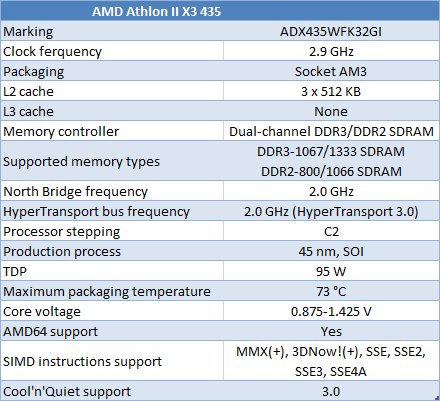
Coming in a clock frequency of 2.9GHz and designed for the Socket AM3 platform the Athlon 2 X3 435 retains backward compatibility with the AM2 socket boards. If you are planning on overclocking we highly recommend getting a board with the SB750 (or later) chip to unlock the full potential of the new chips.
While AMD still officially supports up to 1333MHz DDR3 we haven’t had any problems running up to 2GHz on the ram so we feel that 1333MHz is a little conservative.
Utilizing the 45nm, SOI production process and featuring a TDP of 95W the Athlon 2 X3 435 should be good to go for HTPC or every day computing. Allowing for up to 73° C top end thermal temperature you should get quite a lot of overclocking headroom on the Athlon 2 X3 435 using just air cooling which makes the CPU even more attractive for budget minded end users.

Since AMD has saturated the market with different performance and price points we hooked this processor series chart from the AMD FTP so you can see how the processors position in AMD’s marketing strategy. The Phenom 2 and Athlon 2 segments are split into 3 layers each, Dual core, Triple core, and Quad Core. If you’ll notice the biggest difference between the Phenom 2 and Athlon 2 lineup is the Athlon 2 lineup has no L3 cache. The lack of L3 cache will hurt performance a little but the attractive price point more than makes up for the lack of L3 cache.
A Closer Look

The Athlon 2 X3 435 comes with the full IHS (Integrated Heat Spreader) we’ve become accustomed to seeing for the last few years and like most processors isn’t very conducive for photography. We always wondered why the CPU vendors didn’t put a logo picture on the CU’s but since they are destined to live under a CPU cooler it’s not much of an issue. One of those AMD Dragons emblazoned on the chip would look sharp though.

The back of the chip reveals that it is the AM3 package but like we mentioned earlier it maintains backwards compatibility with the AM2 series boards.
Testing & Methodology
We did a fresh load of Vista Ultimate 64 bit on the Crucial 128GB SSD and loaded all the latest motherboard drivers for the Asus board. We updated the BIOS to the newest available BIOS at the time of testing. We ran each test 3 times and report the average of each three pass run here.
We’ve added several new CPU benches and while we didn’t have the time to go back and bench all the CPU’s we’ve tested, we did go back and test the i7 965 and Phenom 2 X4 965 so we would have comparison numbers. At the bottom of the page you will find the new benches listed.
We think it only fair to mention that the Athlon 2 X3 435 is going against some of the most powerful and expensive CPU’s on the planet and won’t be held to the same standard. You can’t compare a $1000 processor to an $87 dollar processor but we have to have something for comparison.
Test Rig
| Test Rig “Quadzilla i5” |
|
| Case Type | Sunbeam 9 Bay Acrylic Chassis |
| CPU | Athlon 2 X3 435 |
| Motherboard | Asus M3A78-T |
| RAM | Kingston HyperX DC DDR3 1600 4 GB Kit Cas 8 |
| CPU Cooler | Custom Dual Radiator Water Cooling (Swiftech) |
| Hard Drives | Crucial 128 GB SSD(MLC/Samsung controller) |
| Optical | Sony DVD R/W |
| GPU(s) | Gigabyte 4890 OC |
| Case Fans | 120mm Fan cooling the mosfet CPU area |
| Docking Stations | None |
| Testing PSU | Tagan BZ 700w Modular |
| Legacy | None |
| Mouse | Razer Lachesis |
| Keyboard | Razer Lycosa |
| Gaming Ear Buds |
Razer Moray |
| Speakers | None |
| Any Attempt Copy This System Configuration May Lead to Bankruptcy |
|
Test Suite
|
Benchmarks |
|
Excel 2007 |
|
Blender |
|
SiSoft SANDRA XII Professional SP2 |
|
Everest Ultimate Edition v. 5.0 |
|
AutoMKV |
|
Cinebench R10 64 bit |
|
WinRar v. 3.71 |
|
POVRay |
|
Pro Show Gold |
Like we mentioned we ran each test 3 times on each CPU then averaged the results, the average is reported here. Some tests we ran more than 3 times and in that case we averaged all the results. If we happened to get a seriously out of range result we discarded to anomalous result and repeated the test.
We kept most of the Synthetic Benchmarks but added a lot of real life benchmarks. This is a trend you will see a lot more of at Bjorn3D. For Winrar we added a workload test consisting of compressing 5 large images, Pro Show Gold we encode a video file, Excel we run calculations on two large spreadsheets, Blender we render a wire frame photo, and AutoMKV we encode another large video file. While synthetic benches are good, real life testing with heavily multi-threaded applications that take advantage of more than 2 cores is long overdue. These applications are heavily multi-threaded and well coded to take advantage of all the cores.
Everest Ultimate

“EVEREST Ultimate Edition is an industry leading system diagnostics and benchmarking solution for enthusiasts PC users, based on the award-winning EVEREST Technology. During system optimizations and tweaking it provides essential system and overclock information, advanced hardware monitoring and diagnostics capabilities to check the effects of the applied settings. CPU, FPU and memory benchmarks are available to measure the actual system performance and compare it to previous states or other systems. Furthermore, complete software, operating system and security information makes EVEREST Ultimate Edition a comprehensive system diagnostics tool that offers a total of 100 pages of information about your PC.”
CPU AES
This integer benchmark measures CPU performance using AES (a.k.a. Rijndael) data encryption. It utilizes Vincent Rijmen, Antoon Bosselaers and Paulo Barreto’s public domain C code in ECB mode.
CPU AES test uses only the basic x86 instructions, the test consumes 48 MB memory, and it is Hyper Threading, multi-processor (SMP) and multi-core (CMP) aware.

Before we get any farther we’d like to remind you that most of the CPU’s on our charts are much more expensive than the Athlon 2 X3 435 which comes in at $87. Even the Intel Core 2 Duo E8400 still retails for $167 and it’s a dual core.
Taking into consideration the cost of the other processors the Athlon 2 X3 435 which typically runs less than half the cost of the least expensive processors on the charts and in this case outperformed the E8400 and Phenom 2 X3 720 the Athlon 2 X3 435 is looking pretty good.
CPU PhotoWorxx
This integer benchmark performs different common tasks used during digital photo processing.
It performs the following tasks on a very large RGB image:
• Fill
• Flip
• Rotate90R (rotate 90 degrees CW)
• Rotate90L (rotate 90 degrees CCW)
• Random (fill the image with random colored pixels)
• RGB2BW (color to black & white conversion)
• Difference
• Crop
This benchmark stresses the integer arithmetic and multiplication execution units of the CPU and also the memory subsystem.
CPU PhotoWorxx test uses only the basic x86 instructions, and it is Hyper Threading, multi-processor (SMP) and multi-core (CMP) aware.
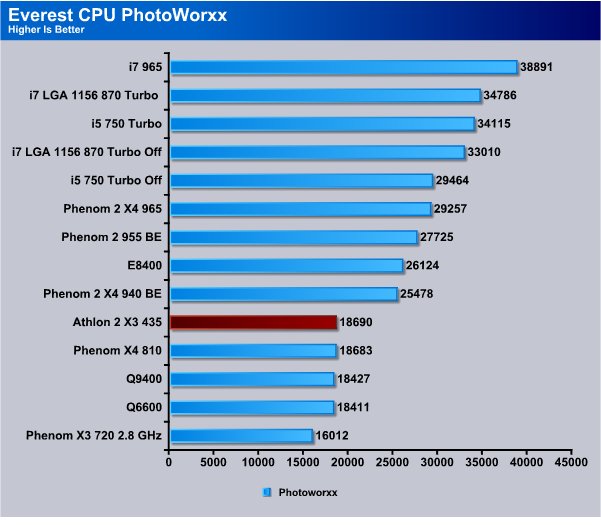
Photoworxx shows the Athlon 2 X3 435 coming in ahead of a couple of the Intel Core 2 Quad series and again ahead of the Phenom 2 X3 720 and performance is looking good on the Athlon 2 X3 435. We aren’t looking for top of the chart performance from an $87 CPU but topping much more expensive CPUs will quickly make the Athlon 2 X3 435 a popular budget enthusiast chip.
CPU Queen
This simple integer benchmark focuses on the branch prediction capabilities and the misprediction penalties of the CPU. It finds the solutions for the classic “Queens problem” on a 10 by 10 sized chessboard.
CPU Queen test uses integer MMX, SSE2 and SSSE3 optimizations. It consumes less than 1 MB system memory and it is Hyper Threading, multi-processor (SMP) and multi-core (CMP) aware.

We’ve had a little more experience with the Phenom 2/Athlon 2 series chips so that may be why the Athlon 2 X3 435 is topping the Phenom 2 X3 720 in most of the charts. At the Athlon 2 X3 435’s price point we don’t see anything to complain about here.
CPU ZLib
This integer benchmark measures combined CPU and memory subsystem performance through the public ZLib compression library Version 1.2.3 (http://www.zlib.net).
CPU ZLib test uses only the basic x86 instructions, and it is Hyper Threading, multi-processor (SMP) and multi-core (CMP) aware.
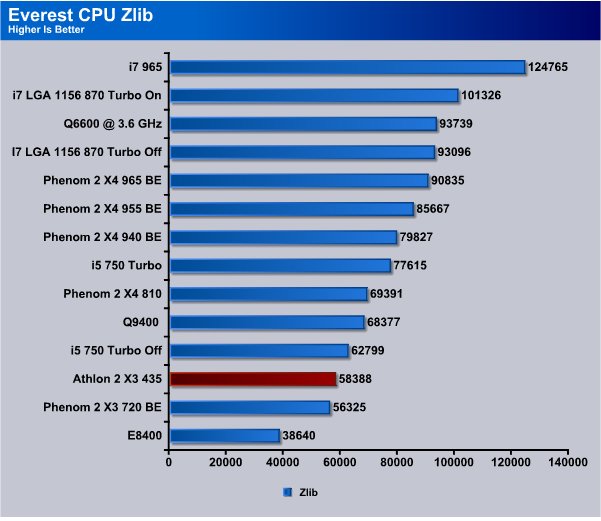
Notice the uber expensive i7 965 scoring 124765 and the Athlon 2 X3 435 scoring a 58288. Lets do a little notepad math here, running $999 (approx) the I7 965 would have to score in excess of 583880 to compete at the same price performance level. While it’s scoring about 2 1/2 times higher than the X3 435 it cost 10 times as much so the Athlon 2 X3 435 is showing a great price performance ratio.
Everest Memory
Using the same kit we used for the i5/i7 LGA 1156 platform we see that Intels new dual channel memory controller is more efficient than the AMD dual channel memory controller but we’re not sure if the extra memory performance is going to do much for real life applications. The Athlon 2 X3 435 hit 10.348GB/s in the copy test and that’s about mid range for all the testing we’ve done in this series.
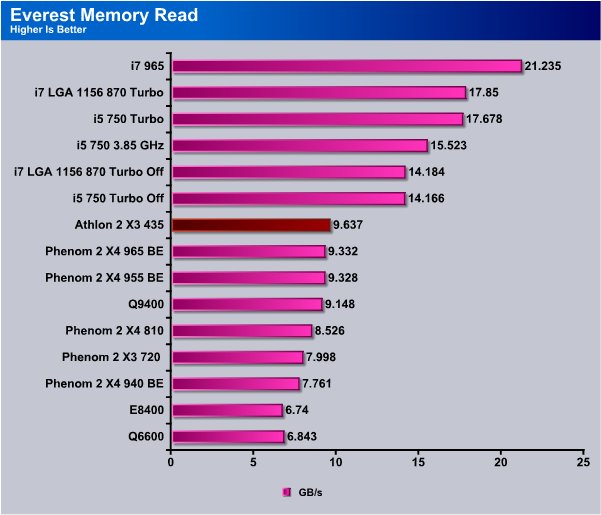
In the Memory Read test we see about the same thing going on, the Big Dog i7 LGA 1366 tops the charts then it’s LGA 1156 in the next five slots followed by the Athlon 2 X3 435 which again sits about mid-pack.
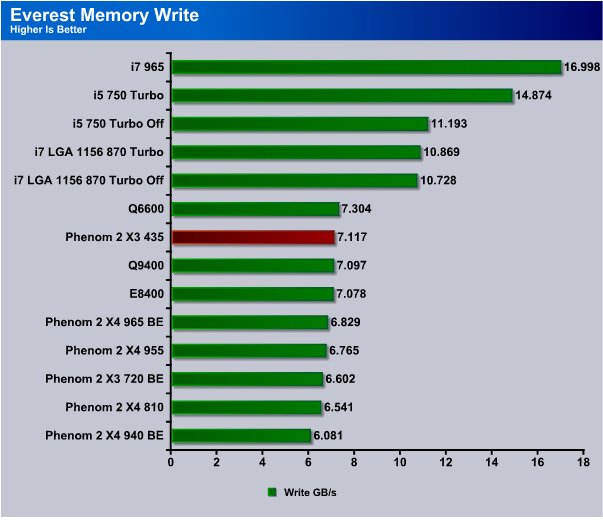
The Memory Write test confirms what we have been seeing in Everest so far, the LGA 1366 Triple Channel memory turns in higher numbers but the LGA 1156 Dual Channel DDR3 is turning in higher numbers than DDR3 Dual channel than we’ve seen on any previous platform utilizing Dual Channel DDR3. The Q6600 from the older LGA 775 platform managed to squeeze ahead of the Athlon 2 X2 435 but the X3 435 is still making a pretty good showing at it’s price point.
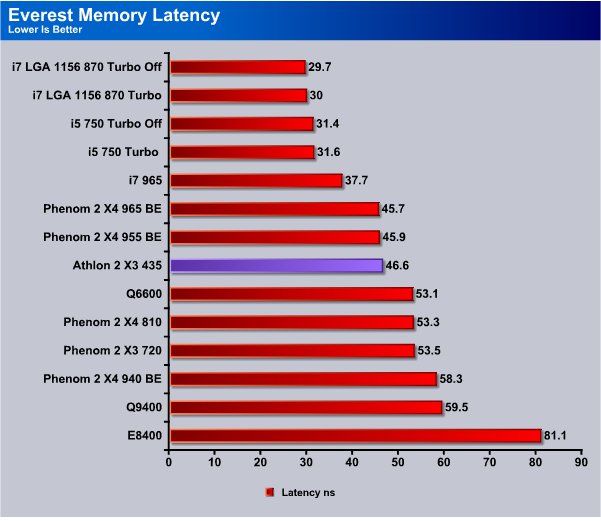
Once again we see the Athlon 2 X3 435 running mid pack on the charts and the Latency on the memory (Kingston HyperX 1600MHz 8-8-8 4GB kit) was running 46.6ns latency. Again running mid-pack on the chart which is pretty good for the least expensive CPU on the charts.
Sisoft Sandra
“SiSoftware Sandra (the System Analyser, Diagnostic and Reporting Assistant) is an information & diagnostic utility. It should provide most of the information (including undocumented) you need to know about your hardware, software and other devices whether hardware or software. It works along the lines of other Windows utilities, however it tries to go beyond them and show you more of what’s really going on. Giving the user the ability to draw comparisons at both a high and low-level. You can get information about the CPU, chipset, video adapter, ports, printers, sound card, memory, network, Windows internals, AGP, PCI, PCI-X, PCIe (PCI Express), database, USB, USB2, 1394/Firewire, etc.”
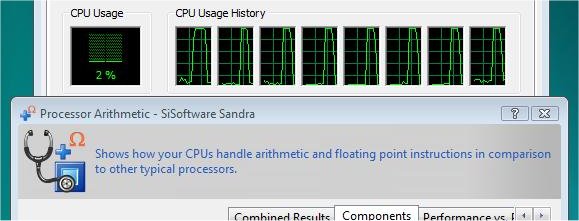
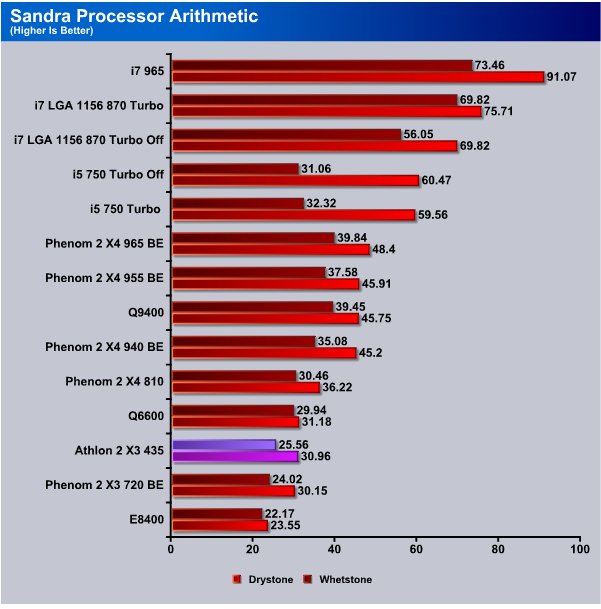
The Sandra Processor Arithmetic test shows about what we expected from the budget processor but coming in ahead of the Phenom 2 X3 720 is a feather in it’s cap.
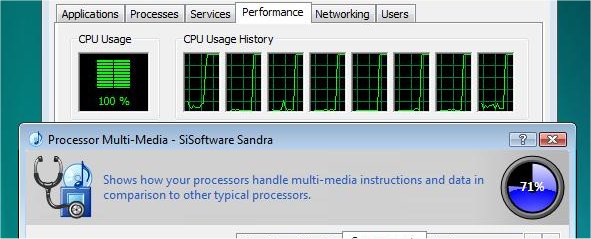
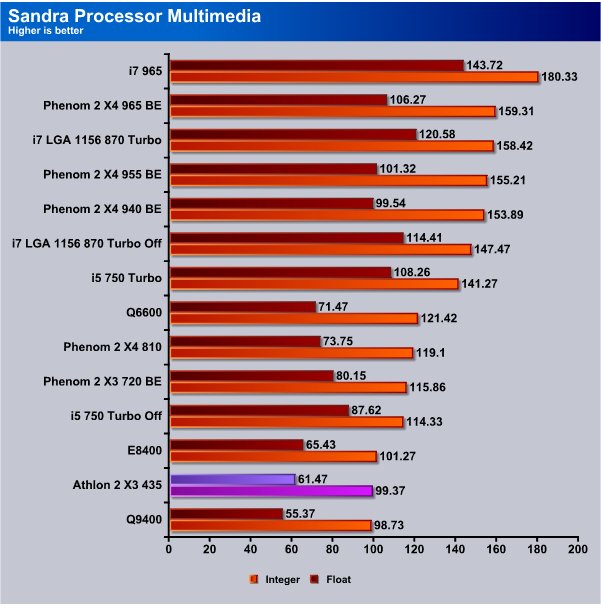
The Sandra Multimedia test usually puts CPU’s all over the charts and this was no exception. The Q9400 bottomed out the chart but the E8400 came out ahead of the Athlon 2 X3 435 and Q9400 this result had us scratching our head and we repeated the test a total of 6 times to level out any errors.
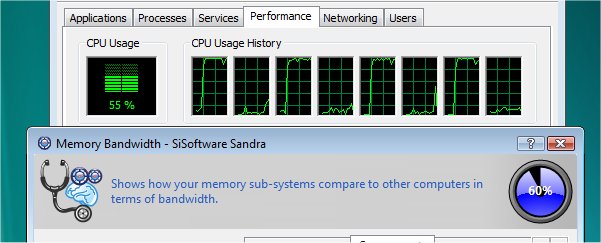
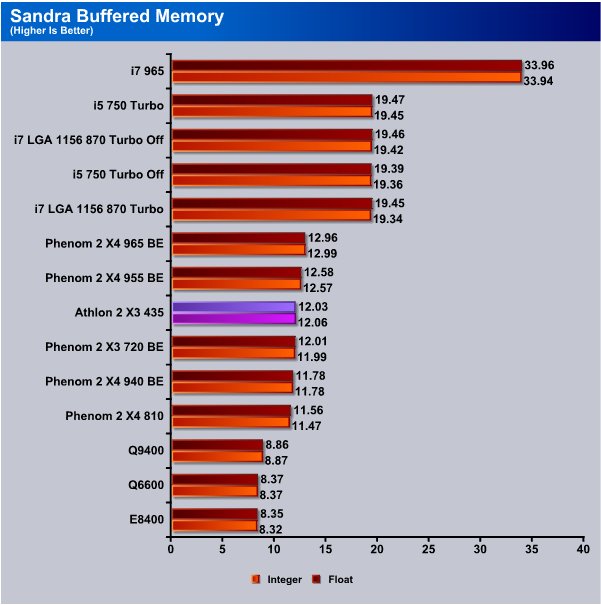
The Sandra Buffered Memory test shows us the same standings as Everest did, the i7 965 tops the chart with it’s Triple Channel DDR3 advantage, and the next six slots fall to the LGA 1156 platform. Behind those CPU’s we see a couple of Phenoms then the Athlon 2 X3 435 which is still showing us excellent price performance punch.
POV-Ray 3.7 Beta 25

The Persistence of Vision Ray-Tracer was developed from DKBTrace 2.12 (written by David K. Buck and Aaron A. Collins) by a bunch of people (called the POV-Team) in their spare time. It is a high-quality, totally free tool for creating stunning three-dimensional graphics. It is available in official versions for Windows, Mac OS/Mac OS X and i86 Linux. The POV-Ray package includes detailed instructions on using the ray-tracer and creating scenes. Many stunning scenes are included with POV-Ray so you can start creating images immediately when you get the package. These scenes can be modified so you do not have to start from scratch. In addition to the pre-defined scenes, a large library of pre-defined shapes and materials is provided. You can include these shapes and materials in your own scenes by just including the library file name at the top of your scene file, and by using the shape or material name in your scene. Since this is free software feel free to download this version and try it out on your own.
Some of you might have seen version 3.6 of POV-Ray, the biggest difference between 3.6 and 3.7 Beta 25 is SMP (symmetric multiprocessing) support, which means that POVRay can take advantage of as many cores as your CPU has. On Single vs Dual CPU systems the speed almost doubles.

In PovRay we see the Athlon 2 X3 435 turning in a 9.73 second score and beating a couple of the LGA 1156 processors so performance here is more than acceptable.
Cinebench

“CINEBENCH is a real-world test suite that assesses your computer’s performance capabilities. MAXON CINEBENCH is based on MAXON’s award-winning animation software, CINEMA 4D, which is used extensively by studios and production houses worldwide for 3D content creation. MAXON software has been used in blockbuster movies such as Spider-Man, Star Wars, The Chronicles of Narnia and many more. MAXON CINEBENCH runs several tests on your computer to measure the performance of the main processor and the graphics card under real world circumstances. The benchmark application makes use of up to 16 CPUs or CPU cores and is available for Windows (32-bit and 64-Bit) and Macintosh (PPC and Intel-based). The resulting values among different operating systems are 100% comparable and therefore very useful with regard to purchasing decision-making. It can also be used as a marketing tool for hardware vendors or simply to compare hardware among colleagues or friends.”
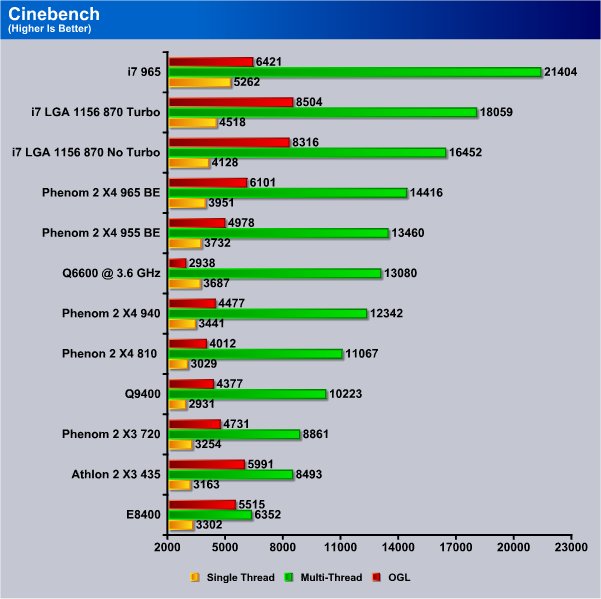
The Cinebench test shows the Athlon 2 X3 435 coming in next to last on the chart but again we have to take into consideration the cost of the budget CPU and with the E8400 about double what the X3 435 costs there’s not a lot to complain about. With performance very close to the Phenom 2 X3 720 we still have to say from a price/performance standpoint the X3 435 is an exceptional value.
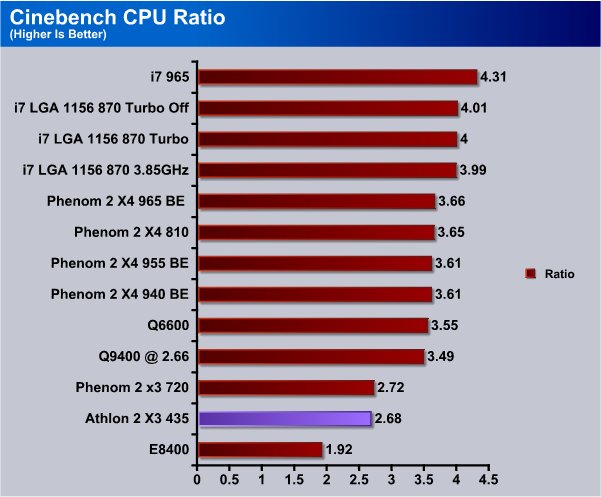
In Cinebench CPU Ratio which measures the efficiency of the multiple cores cooperation we got a 2.68 which isn’t stellar performance but it’s still a good ratio for a non-hyperthreaded CPU.
WinRar v. 3.71

This module in WinRar generates random data, which contains specially introduced redundancy, increasing the load to both the processor and memory. Data is then passed through RAR compression and decompression algorithms, and the output of the decompression algorithm is compared to the source data. If any differences are found, WinRar then reports “Errors found – Yes” in the command window. WinRar displays a size of processed data and compression speed, current and resulting, in kilobytes per second.
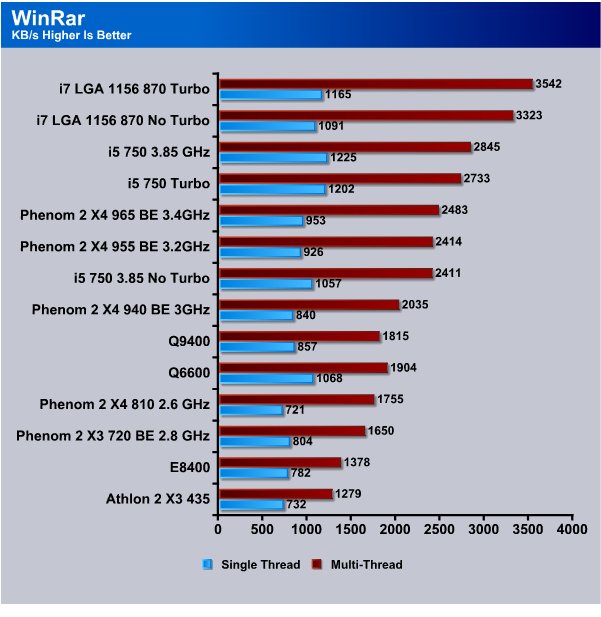
The Winrar built in benchmark shows the Athlon 2 X3 435 bottoming out the chart but it’s $87 dollar price tag and performance similar to the E8400 in test still shows a pretty good price/performance ratio.
Winrar Workload
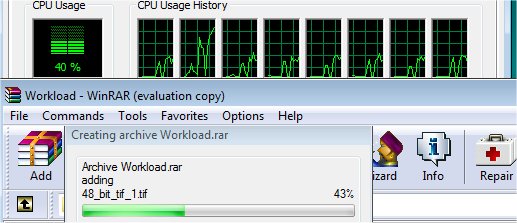
The Winrar workload test we bypass the built in benchmark and throw 5 large .tif images at Winrar then compress them and record the compression time. Total workload is about 350MB or 70+ MB per TIF image. The real life compression test of a group of large image files should give us a more realistic idea of how the CPU’s perform than the built in benchmark.
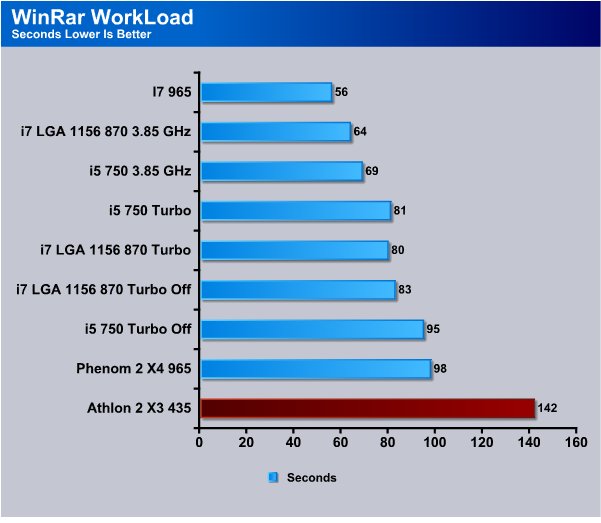
The Winrar workload test is new for Bjorn, and we had time to go back and get the results from the i7 965 and the Phenom 2 X4 965. As we review more CPU’s we’ll add those to the chart. The i7 965 again comes in on top the chart keeping it’s Big Dog mantle followed by the overclocked I7 870. Behind the i7 870 we see the overclocked i5 750 and the i5 750 in Turbo mode. The the new CPU’s held to their stock clocks with no Turbo followed by the Phenom 2 X4 965 coming in right above the Athlon 2 X3 435. The Phenom 2 X4 965 gave 1/3 better performance but at more than double the cost of the Athlon 2 X3 435 so we are still seeing a good price performance from the Athlon 2 X3 435.
Microsoft Excel 2007
Monte Carlo Black-Scholes Option Pricing Test
Microsoft Excel is the widely known and most used spreadsheet application for the manipulation and calculation for number crunching. With Excel you can analyze and share information on small scale or the largest scale you can imagine. We’ve seen spreadsheets in every day use that contain literally tens of thousands of numbers and hundreds of equations. Bjorn3D uses two tests in Excel to determine CPU and Motherboard performance.

This workload calculates the European Put and Call option valuation for Black-Scholes option pricing using Monte Carlo simulation. It simulates the calculations performed when a spreadsheet with input parameters is updated and must recalculate the option valuation. In this scenario we execute approximately 300,000 iterations of Monte Carlo simulation. In addition, the workload uses Excel lookup functions to compare the put price from the model with the historical market price for 50,000 rows to understand the convergence. The input file is a 70.1 MB spreadsheet.
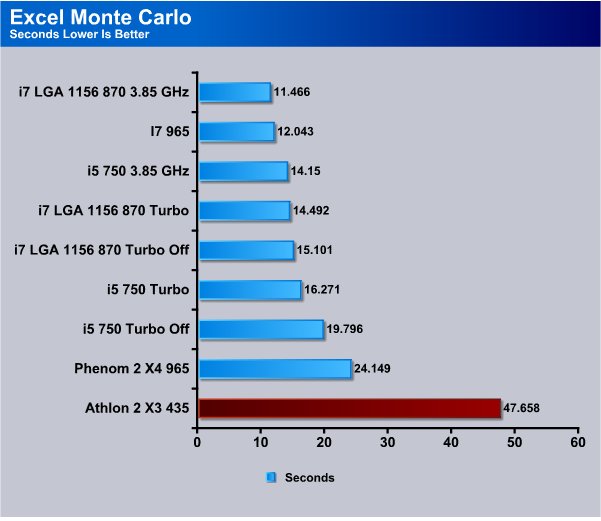
In the Excel Monte Carlo Black Scholes Option Pricing test we see the Athlon 2 X3 435 on the bottom of the chart which isn’t surprising considering the CPU’s we have to put against it. We really wish we had more price point comparable CPU’s to put against it but we have to work with what’s available. Take the Phenom 2 X4 965 which retails for about $229.95 – 249.95 and costs about 3 times what the Athlon 2 X3 435 costs, it performs about twice as fast as the Athlon 2 X3 435 but again at 3 times the cost.
Big Number Crunch
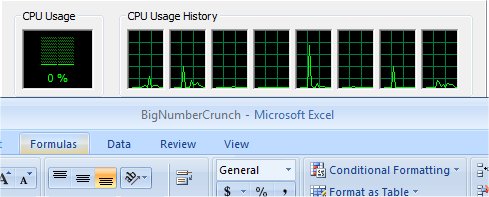
This workload is from a 6.2 MB spreadsheet and executes about 28,000 sets of calculations. It uses the most common calculations in Excel, addition, subtraction, division, rounding and Square Root. It also analyzes statistical functions such as Min, Max Median, and Average. The calculations are done after the spreadsheet with a large data set is updated with new values and must recalculate a large number of data points.
We feel the addition of Excel to our real life benchmarks is an important one. Excel has a huge user base and is one of the most widely used applications worldwide. While Excel will run on almost and modern machine it’s the CPU performance that will determine how fast it runs making it a good application for judging CPU and Motherboard performance.
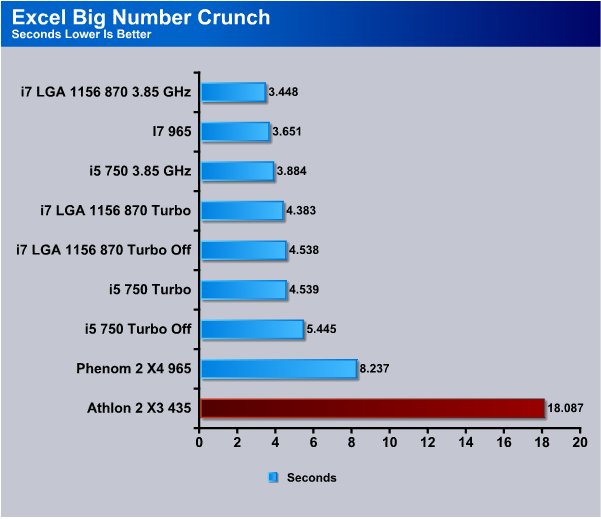
Again we see the Athlon 2 X3 435 bottoming the chart and that’s what we expect at this price. Keeping in mind that the X4 965 is about 3 times the cost the Athlon 2 X3 435 is still showing a good price/performance punch.
Photodex ProShow Gold 3.2
ProShow Gold allows you to combine videos and photos and music to create slide shows, depending on the end user results can be spectacular. The application allows the end user to share photos and memories with friends in a unique and spectacular way, the different formats supported are, DVD, PC and Web. Still Photos are brought to life by adding motion effects. Supported effects include, Pan, Zoom, and rotate. You can also add captions and over 280 transition effects.

The workload we use consists of 29 high resolution images in JPG format and converts them to MPEG2 wide screen DVD quality. The end result is a 3 minute 9 second video file in slideshow format. The images are in 3872×2592 resolution and have a combined total size of about 170 MB.
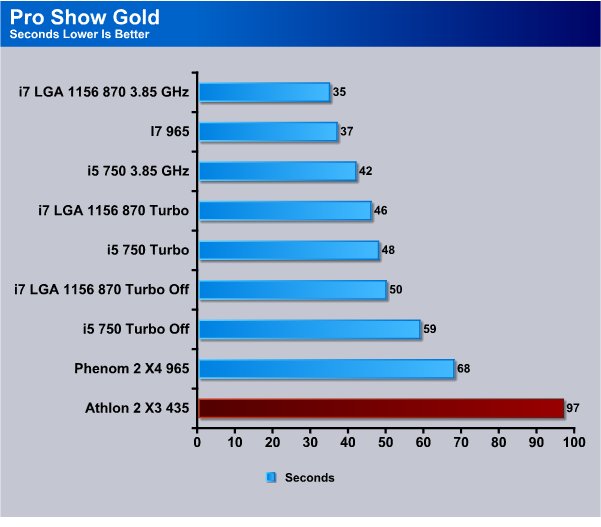
We spent a lot of time with ProShow Gold before adding it to our benchmarks, checking the image above, and seeing that it’s driving a 4 core hyperthreaded CPU for all it’s worth should tell you why it made the cut.
In ProShow Gold we see the Phenom 2 X4 965 running about 1/3 faster than the Athlon 2 X3 435 and given the large price difference the Athlon 2 X3 435 is holding it’s own in it’s market segment.
AutoMKV 0.95c
AutoMKV is an application aiming for easy media conversion between various media formats using various third party codecs. With improved internet speed and enhanced computing power, more users are interested in encoding to different media formats for their various multimedia needs. With AutoMKV and x264 codec, a freeware H.264 encoder, users can easily create media files. For more information and to obtain AutoMKV 0.95c and AviSynth* 2.5.7, please visit (http://forum.doom9.org/showthread.php?t=134478). We create a media file using AutoMKV and x264 codec. The input file used in the document is a raw 416 MB 720×480 DV file and the output is a 253MB H.264 media file.
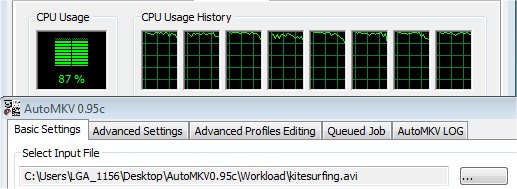
Looking at the Task manager with AutoMKV driving all 8 cores is a good indication that it’s great for evaluating multi-core CPU’s. Most of the encoding we saw drove the CPU’s at or close to 100%.
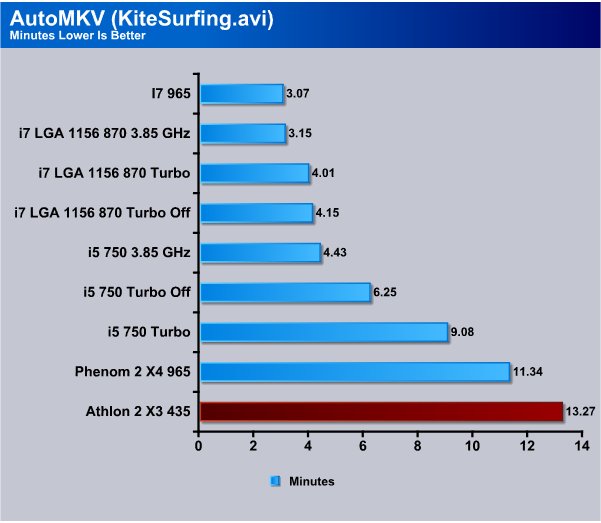
The Athlon 2 X3 435 churned out a respectable 13.27 minutes in the demanding AutoMKV test which is only 2 minutes behind the much more expensive Phenom 2 X4 965 so again from a price/performance standpoint the X3 435 is a good value.
Blender
Blender is a free open source 3D content creation suite that is available for various operating systems. The application is popular among many independent animation studios and game makers. For more information, please visit http://www.blender.org/.
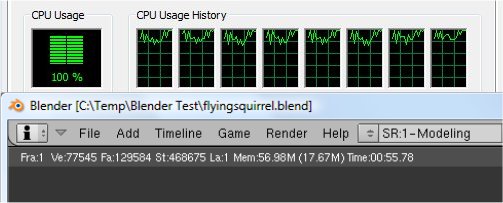
The workload consists of a ~6.9 MB character model of a flying squirrel. Due to time constraints we don’t render the entire image which would be time consuming and rather pointless except to yield larger benchmark numbers. A portion of the image, the right arm is what we render, it’s a large enough portion to show differences in CPU performance, yet small enough that we don’t have to grind through a 45 minute Render waiting for a single result.
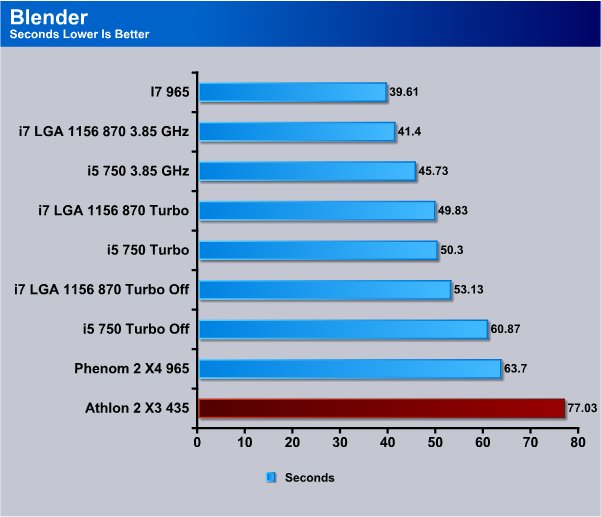
It’s going to take more testing with Blender before it becomes a regular in the benchmark suite but since we ran several hours of testing with it we thought we’d toss in the results because it is heavily multi-threaded.
The Athlon 2 X3 435 came in 14.7 seconds behind the Phenom 2 X4 965 and we’ve harped on the price difference enough that that point should be hammered into your brain at this point. We all know that higher performing CPUs cost more and often that last little bit of performance will cost you dearly. With CPU’s appearing at all price points it’s almost a designer market. The Athlon 2 X3 435 would be great for an HTPC, work PC, normal home computing with moderate gaming abilities, and in normal every day use for about 2 weeks we had no problem with the Athlon 2 X3 435 running anything we do on a day to day basis.
CPU-Z & Overclocking
Lets jump right to a CPU-Z shot of the Athlon 2 X2 435 CPU then get on with the Yada yada.
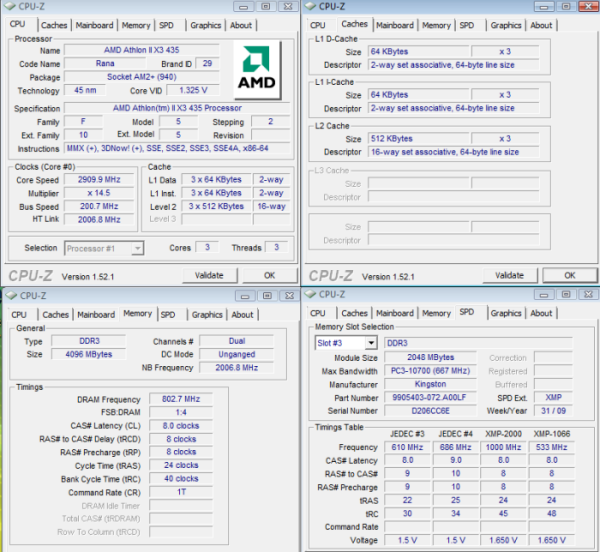
Coming in at 2.9GHz stock speed the Athlon 2 X3 435 should be fast enough at stock speed for 90% of all end users. The other 10% we would expect to be dabbling at OCing or needing a quad core for photo, video or sound editing. Notice the Cache page of CPU-Z confirms that there is indeed no L3 cache which will hamper performance somewhat but if your looking for a good reliable processor to do the job at a budget price the Athlon X3 435 is hard to beat.
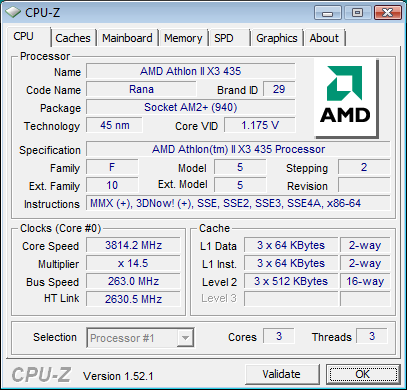
CPU-Z is reading the CPU voltage wrong and at 3.8GHz the highest stable OC we managed on the Athlon 2 X3 435 we were using 1.50v but increasing the voltage to 1.55v the highest safe voltage for air cooling didn’t yield any bette results. We had limited time with the CPU so spending a little more time with it might yield better results.
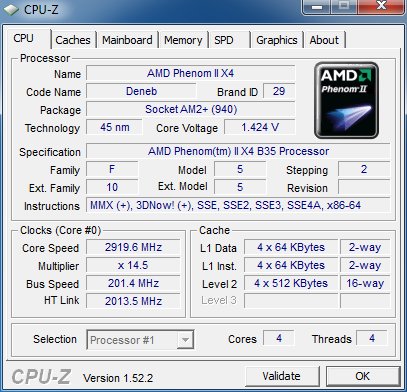
Notice we unlocked the core on our Athlon 2 X3 435 and CPU-Z is reading it as a Phenom 2 X4 B35 processor, our X3 435 was totally stable at 2.9 GHz and ran with no problems at this speed. We did overclock the CPU with the core unlocked and the best we hit was 3.5Ghz stable @ 1.47v and anything beyond 3.5GHz was unstable.
Now to unlock the Core you need a board with Advanced Clock calibration and for that task we slapped the CPU on a Gigabyte GA-MA790FXT-UD5P and enabled Advanced Clock Calibration and rebooted and the 4th core appeared. Please note that as we’ve told you there is no guarantee you can enable the fourth core and we just got lucky and got one with a good 4th core but we lost 300MHz OCing capability to unlock that core. We would consider a 300MHz loss OCing but gaining a 4th core a win.
We didn’t expect stellar performance from the Athlon X3 435 but we also didn’t expect it to have such a nice price/performance ratio. It’s hard to fault an $87 CPU that can do what 90% of end users need it to do without sacrificing performance.
With CPU’s appearing at every price and performance point we can think of, it’s almost a designer CPU market. You can pick and choose a CPU to meet your specific needs. The Athlon 2 X3 435 isn’t a top end CPU but it will fit the bill for a large percentage of end users that frankly don’t need or want top end performance. With a TDP of 95w it will work great for a luxury HTPC, normal computing in every day use we didn’t notice much difference from our i5 870 which is a quad core.
We did see differences in heavily multi-threaded applications, photo editing, and video editing but photo editing and video editing is just a small percentage of end users. This would make a perfect first CPU a student, moderate to heavy gaming depending on the GPU it’s paired with.
We ran Crysis on the X3 435 and paired it with a Gigabyte 4890 OC and had no problems running the killer game at high settings. If it will run Crysis at high settings and a 4890 OC it will make a killer gaming rig. The games (few and far between) that will use a Quad core will suffer a little but with so few titles utilizing a quad this CPU will do the job.
We like the value the Athlon X3 435 offers at it’s $87 price point. It will most likely end up in a HTPC we’ve been thinking about paired with the Gigabyte 790 board we unlocked the extra core on. An inexpensive Quad core (Triple core with one core unlocked) with the board and CPU hitting the $160 price range sounds pretty darn good to us.
We are using an addition to our scoring system to provide additional feedback beyond a flat score. Please note that the final score isn’t an aggregate average of the rating system.
- Performance 7.5
- Value 10
- Quality 10
- Warranty 10
- Features 8.5
- Innovation 8.5
Pros:
+ Great Price/Performance Ratio
+ Might Be Able To Unlock The 4th Core
+ Runs Cool Enough
+ Am2+ Backward Compatible
+ Inexpensive
+ Overclocks Well
Cons:
– Not A Top Performer
– Might Not Be Able To Unlock the 4th Core
The AMD Athlon 2 X3 435 held it’s own at it’s price point and offers good performance at a low TDP of 95w. Performance was high enough that in 2 weeks of daily use we didn’t see anything that would prevent us from using it as a daily driver. With a Price of $87 bucks and an inexpensive platform to set it on the Athlon 2 X3 435 is a great choice for a budget enthusiast PC so it earn a 7.5 and the Bjorn3D Seal of Approval and Best Bang for Buck Award
| CPU Name | Cores | Clock | L2/L3 Cache | HT Bus | Socket | TDP | Price |
| AMD Phenom II X4 965 BE | 4 | 3.4GHz | 2+6MB | 4000MHz | AM3 | 140W | $179 |
| AMD Phenom II X4 955 BE | 4 | 3.2GHz | 2+6MB | 4000MHz | AM3 | 125W | $165 |
| AMD Phenom II X4 945 | 4 | 3.0GHz | 2+6MB | 4000MHz | AM3 | 125W | $159 |
| AMD Phenom II X4 925 | 4 | 2.8GHz | 2+6MB | 4000MHz | AM3 | 95W | $139 |
| AMD Phenom II X4 910e | 4 | 2.6GHz | 2+6MB | 4000MHz | AM3 | 65W | $169 |
| AMD Phenom II X4 905e | 4 | 2.5GHz | 2+6MB | 4000MHz | AM3 | 65W | $175 |
| AMD Phenom II X4 810 | 4 | 2.6GHz | 2+4MB | 4000MHz | AM3 | 95W | $139 |
| AMD Phenom II X3 720BE | 3 | 2.8GHz | 1.5+6MB | 4000MHz | AM3 | 95W | $104 |
| AMD Phenom II X3 710 | 3 | 2.6GHz | 1.5+6MB | 4000MHz | AM3 | 95W | $99 |
| AMD Phenom II X3 705e | 3 | 2.5GHz | 1.5+6MB | 4000MHz | AM3 | 65W | $119 |
| AMD Phenom II X2 555 | 2 | 3.2GHz | 1+6MB | 4000MHz | AM3 | 80W | $99 |
| AMD Phenom II X2 550 | 2 | 3.1GHz | 1+6MB | 4000MHz | AM3 | 80W | $91 |
| AMD Athlon II X4 635 | 4 | 2.9GHz | 2MB | 4000MHz | AM3 | 95W | $120 |
| AMD Athlon II X4 630 | 4 | 2.8GHz | 2MB | 4000MHz | AM3 | 95W | $102 |
| AMD Athlon II X4 620 | 4 | 2.6GHz | 2MB | 4000MHz | AM3 | 95W | $99 |
| AMD Athlon II X3 440 | 3 | 3.0GHz | 1.5MB | 4000MHz | AM3 | 95W | $84 |
| AMD Athlon II X3 435 | 3 | 2.9GHz | 1.5MB | 4000MHz | AM3 | 95W | $75 |
| AMD Athlon II X3 425 | 3 | 2.7GHz | 1.5MB | 4000MHz | AM3 | 95W | $72 |
| AMD Athlon II X2 255 | 2 | 3.1GHz | 2MB | 4000MHz | AM3 | 65W | $75 |
| AMD Athlon II X2 250 | 2 | 3.0GHz | 2MB | 4000MHz | AM3 | 65W | $65 |
| AMD Athlon II X2 245 | 2 | 2.9GHz | 2MB | 4000MHz | AM3 | 65W | $61 |
| AMD Athlon II X2 240 | 2 | 2.8GHz | 2MB | 4000MHz | AM3 | 65W | $53 |
 Bjorn3D.com Bjorn3d.com – Satisfying Your Daily Tech Cravings Since 1996
Bjorn3D.com Bjorn3d.com – Satisfying Your Daily Tech Cravings Since 1996
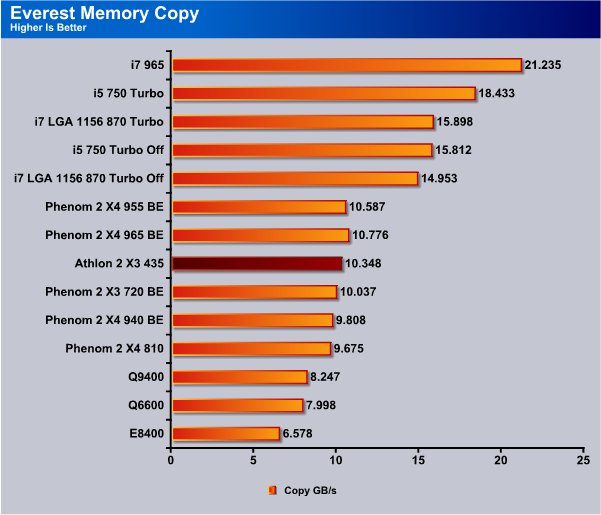





just got one and unlocked the 4th core yay 🙂 Runs stable on Bad company 2